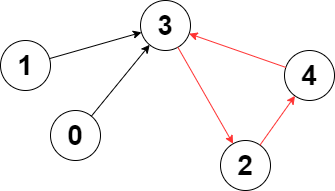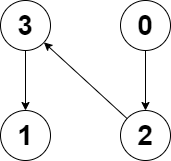
g2301_2400.s2360_longest_cycle_in_a_graph.Solution Maven / Gradle / Ivy
package g2301_2400.s2360_longest_cycle_in_a_graph;
// #Hard #Depth_First_Search #Graph #Topological_Sort
// #2022_08_14_Time_37_ms_(90.19%)_Space_102.8_MB_(72.92%)
/**
* 2360 - Longest Cycle in a Graph\.
*
* Hard
*
* You are given a **directed** graph of `n` nodes numbered from `0` to `n - 1`, where each node has **at most one** outgoing edge.
*
* The graph is represented with a given **0-indexed** array `edges` of size `n`, indicating that there is a directed edge from node `i` to node `edges[i]`. If there is no outgoing edge from node `i`, then `edges[i] == -1`.
*
* Return _the length of the **longest** cycle in the graph_. If no cycle exists, return `-1`.
*
* A cycle is a path that starts and ends at the **same** node.
*
* **Example 1:**
*
* 
*
* **Input:** edges = [3,3,4,2,3]
*
* **Output:** 3
*
* **Explanation:** The longest cycle in the graph is the cycle: 2 -> 4 -> 3 -> 2.
*
* The length of this cycle is 3, so 3 is returned.
*
* **Example 2:**
*
* 
*
* **Input:** edges = [2,-1,3,1]
*
* **Output:** -1
*
* **Explanation:** There are no cycles in this graph.
*
* **Constraints:**
*
* * `n == edges.length`
* * 2 <= n <= 105
* * `-1 <= edges[i] < n`
* * `edges[i] != i`
**/
public class Solution {
public int longestCycle(int[] edges) {
int n = edges.length;
boolean[] vis = new boolean[n];
boolean[] dfsvis = new boolean[n];
int[] path = new int[n];
int maxLength = -1;
for (int i = 0; i < n; i++) {
if (!vis[i]) {
path[i] = 1;
maxLength = Math.max(maxLength, dfs(i, 1, path, vis, dfsvis, edges));
}
}
return maxLength;
}
private int dfs(
int node, int pathLength, int[] path, boolean[] vis, boolean[] dfsvis, int[] edges) {
vis[node] = true;
dfsvis[node] = true;
int length = -1;
if (edges[node] != -1 && !vis[edges[node]]) {
path[edges[node]] = pathLength + 1;
length = dfs(edges[node], pathLength + 1, path, vis, dfsvis, edges);
} else if (edges[node] != -1 && dfsvis[edges[node]]) {
length = pathLength - path[edges[node]] + 1;
}
dfsvis[node] = false;
return length;
}
}
© 2015 - 2025 Weber Informatics LLC | Privacy Policy